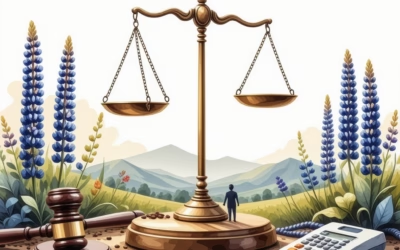Key Takeaways
- Understanding government aid programs is essential for individuals facing financial hardships, providing critical support for food, housing, and healthcare.
- Explore various government cash assistance programs like TANF and SNAP to secure immediate financial relief.
- Utilize resources like Benefits.gov to find local assistance options tailored to your needs.
- Consider hardship grants for unexpected expenses; they offer financial relief without repayment obligations.
- Consult certified financial counselors for personalized strategies in managing debt and navigating government assistance.
- Stay informed about eligibility criteria for programs to maximize your chances of receiving the support you need.
In today’s challenging economic landscape, understanding government aid programs can be a lifeline for individuals and families facing financial hardships. This article, titled Exploring Government Aid Programs: Essential Financial Assistance Options for Those in Need, aims to illuminate the various forms of support available, from government cash assistance programs to specialized government relief programs. We will delve into critical questions such as, “How can I get money if I’m struggling?” and “What is a hardship grant?” to provide clarity on the resources at your disposal. Additionally, we will explore the different types of government assistance programs, including those focused on housing and debt relief, ensuring you have a comprehensive understanding of the options available. Whether you’re seeking financial assistance from government sources or looking for specific housing assistance programs, this guide will equip you with the knowledge needed to navigate the complexities of government support effectively.
How can I get money if I’m struggling?
If you’re facing financial difficulties, understanding the available resources can be crucial in finding the support you need. One of the most effective ways to secure assistance is through various government aid programs. These programs are designed to help individuals and families navigate tough financial situations by providing essential support.
Understanding Government Aid Programs
Government aid programs encompass a wide range of services aimed at assisting those in need. These programs can provide financial assistance, food support, housing aid, and more. By familiarizing yourself with these options, you can better position yourself to access the help available. Here are some key steps to consider:
- Reach Out to Family and Friends: Consider discussing your financial challenges with trusted family members or friends. They may be willing to provide temporary financial support or help you brainstorm solutions.
- Sell Unwanted Items: Look around your home for items you no longer need or use. Selling these items online through platforms like eBay, Facebook Marketplace, or Craigslist can generate quick cash.
- Explore Loan Options: If you have a steady income, you might consider applying for a personal loan from a bank or credit union. Be sure to compare interest rates and terms to find the best option for your situation.
- Credit Card Advances: If you have a credit card, you may be able to take a cash advance. However, be cautious of high-interest rates and fees associated with this option.
- Ask for an Advance at Work: If you’re employed, consider discussing your situation with your employer. Some companies may offer paycheck advances or emergency loans to employees in need.
- Government Assistance Programs: Look into local and federal assistance programs that can provide financial aid. Websites like Benefits.gov can help you find resources available in your area, including food assistance, housing support, and unemployment benefits.
- Community Resources: Many non-profit organizations and community centers offer financial counseling and assistance programs. Organizations like the United Way can connect you with resources tailored to your needs.
- Financial Counseling: Seeking advice from a certified financial counselor can help you create a budget, manage debt, and explore options for financial recovery.
Overview of Government Cash Assistance Programs
Government cash assistance programs are specifically designed to provide immediate financial relief to individuals and families facing economic hardship. These programs can vary by state and may include:
- Temporary Assistance for Needy Families (TANF): This program offers cash benefits to low-income families with children, helping them meet basic needs.
- Supplemental Nutrition Assistance Program (SNAP): While primarily a food assistance program, SNAP benefits can help free up cash for other essential expenses.
- General Assistance Programs: Many states offer general assistance programs that provide cash aid to individuals without dependent children who are struggling financially.
- Emergency Cash Assistance: Some local governments provide emergency cash assistance for individuals facing unexpected financial crises, such as medical emergencies or job loss.
By exploring these government cash assistance programs, you can find the support you need to navigate your financial challenges effectively. For more information on specific programs available in your state, visit USA.gov for comprehensive resources.

Is There Really a Government Debt Relief Program?
Yes, there are government debt relief programs available, though they vary based on the type of debt. Here’s a detailed overview:
- Federal Student Loan Programs: The U.S. Department of Education provides several options for managing federal student loan debt. Key programs include:
- Income-Driven Repayment Plans (IDR): These plans adjust monthly payments based on income and family size, potentially leading to loan forgiveness after 20-25 years of qualifying payments.
- Public Service Loan Forgiveness (PSLF): This program forgives the remaining balance on Direct Loans after 120 qualifying monthly payments while working full-time for a qualifying employer, such as a government or non-profit organization.
- Tax Debt Relief: The Internal Revenue Service (IRS) offers several programs to assist individuals facing tax debt, including:
- Offers in Compromise: This allows taxpayers to settle their tax debts for less than the full amount owed if they can prove that paying the full amount would cause financial hardship.
- Installment Agreements: Taxpayers can set up a payment plan to pay off their tax debt over time.
- Other Government Assistance: Additional resources include:
- Credit Counseling Services: Non-profit organizations provide counseling to help individuals manage their debts and create budgets.
- Debt Management Programs: These programs help consolidate debts and negotiate lower interest rates with creditors.
- COVID-19 Relief: The Small Business Administration (SBA) implemented relief measures for borrowers affected by the pandemic, including deferment of principal and interest payments on certain loans.
- No Broad Government Debt Relief for Unsecured Debts: It is crucial to understand that there is no comprehensive government program for unsecured debts, such as credit cards or personal loans, outside of bankruptcy options.
- Be Wary of Scams: Many companies falsely claim to offer government debt relief programs. Always verify the legitimacy of any debt relief service before engaging.
- Seek Professional Help: Consulting with a certified credit counselor or financial advisor can provide personalized strategies for managing debt effectively.
- Explore All Options: In addition to government programs, consider resources offered by non-profit organizations and local charities that may provide additional support.
Government Assistance Programs for Debt Relief
Government assistance programs for debt relief are designed to help individuals manage their financial burdens effectively. These programs can provide crucial support, especially during challenging economic times. Here are some key government assistance programs:
- Federal Housing Administration (FHA) Loans: These loans are designed to help low-income individuals and families secure affordable housing. The FHA provides mortgage insurance on loans made by approved lenders, making it easier for borrowers to qualify.
- Home Affordable Modification Program (HAMP): This program helps homeowners at risk of foreclosure by modifying their mortgage terms to make payments more affordable.
- Supplemental Nutrition Assistance Program (SNAP): While primarily a food assistance program, SNAP can help free up funds for other essential expenses, indirectly aiding in debt management.
- Low-Income Home Energy Assistance Program (LIHEAP): This program assists low-income households in paying their energy bills, allowing them to allocate more of their income towards debt repayment.
For more information on government assistance programs, you can visit Benefits.gov for comprehensive details on available resources.
What are three types of government aid?
Government aid can be categorized into three primary types:
- Grants: These are financial aid awards that do not require repayment, making them an ideal option for individuals seeking to minimize debt. Grants are often based on financial need and can come from federal, state, or institutional sources. For example, the Pell Grant is a well-known federal grant designed to assist low-income undergraduate students. According to the U.S. Department of Education, in the 2021-2022 academic year, over 6 million students received Pell Grants, totaling more than $28 billion in funding (source: ed.gov).
- Loans: Unlike grants, loans are borrowed funds that must be repaid with interest. Federal student loans, such as Direct Subsidized and Unsubsidized Loans, offer lower interest rates and more flexible repayment options compared to private loans. The U.S. Department of Education reports that federal student loans have a fixed interest rate, which can help borrowers manage their payments more effectively over time (source: studentaid.gov).
- Work-Study: This federal program provides part-time job opportunities for undergraduate and graduate students, allowing them to earn money to help cover educational expenses. Work-study positions are typically offered by participating schools and can be found in various fields, including community service, research, and campus administration. According to the National Association of Student Financial Aid Administrators, work-study can significantly reduce the financial burden on students while providing valuable work experience (source: nasfaa.org).
Types of Government Grants and Subsidies
Government grants and subsidies play a crucial role in supporting various sectors, including education, housing, and healthcare. Here are some notable types:
- Education Grants: These grants, such as the Pell Grant, are designed to assist students in covering tuition and related expenses, making higher education more accessible.
- Housing Grants: Programs like the Housing Choice Voucher Program (Section 8) provide financial assistance to low-income families, helping them afford safe and decent housing. For more information, visit the U.S. Department of Housing and Urban Development.
- Healthcare Subsidies: These include programs that help individuals and families afford health insurance premiums and out-of-pocket costs, ensuring access to necessary medical services.
Government Assistance Programs for Housing
Government assistance programs for housing are essential for ensuring that low-income families have access to safe and affordable living conditions. Some key programs include:
- Section 8 Housing Choice Voucher Program: This program provides rental assistance to low-income families, allowing them to choose their housing while ensuring that their rent does not exceed a certain percentage of their income.
- Public Housing: Managed by local housing authorities, public housing offers affordable rental units to eligible low-income families, the elderly, and persons with disabilities.
- Low-Income Home Energy Assistance Program (LIHEAP): This program assists low-income households in paying their heating and cooling bills, ensuring that families can maintain a safe living environment.
What are some things the government can help pay for?
The government offers various programs to assist individuals and families with essential expenses. Here are some key areas where government assistance can help pay for:
- Food Assistance: Programs like the Supplemental Nutrition Assistance Program (SNAP) provide financial aid to purchase food. According to the USDA, SNAP benefits help millions of Americans secure nutritious meals.
- Housing Support: The Department of Housing and Urban Development (HUD) offers programs such as Housing Choice Vouchers (Section 8) that assist low-income families in affording safe and decent housing. Additionally, public housing programs provide subsidized housing options.
- Health Care: The Affordable Care Act (ACA) expanded access to health insurance through Medicaid and the Health Insurance Marketplace, helping individuals and families afford necessary medical care. The Centers for Medicare & Medicaid Services (CMS) provide resources for understanding eligibility and enrollment.
- Childcare Assistance: The Child Care and Development Fund (CCDF) helps low-income families pay for childcare so they can work or attend school. This program is crucial for supporting working parents.
- Utility Assistance: The Low-Income Home Energy Assistance Program (LIHEAP) helps eligible households with their heating and cooling energy costs, ensuring that families can maintain a safe living environment.
- Education and Training: The government provides financial aid for education through programs like Pell Grants and federal student loans, which help cover tuition and related expenses for college students.
- Transportation Assistance: Various state and local programs offer transportation subsidies or services to help low-income individuals access jobs and essential services.
For more detailed information on these programs, individuals can visit USAGov or consult local government websites that provide resources tailored to specific needs.
Financial Assistance from Government for Essential Needs
Government aid programs are designed to alleviate financial burdens for those in need. These programs encompass a wide range of services, ensuring that essential needs are met. From food and housing to healthcare and education, the government provides critical support to help individuals and families thrive.
For instance, government help with bills can significantly ease the financial strain on low-income households. Programs like LIHEAP and SNAP are vital for maintaining a stable living environment and ensuring access to nutritious food.
Government Funding for Housing Assistance Programs
Housing assistance programs are a cornerstone of government support for low-income families. These programs not only provide financial aid but also offer resources to help individuals secure stable housing. The HUD administers various initiatives, including public housing and rental assistance programs, which are essential for those struggling to afford housing costs.
Additionally, housing assistance programs can help families navigate the complexities of finding affordable housing options, ensuring that everyone has a place to call home.

What is a hardship grant?
A hardship grant is a type of financial assistance provided by government entities, non-profit organizations, or private foundations to individuals or organizations facing significant financial difficulties. These grants are designed to alleviate the burden of unexpected expenses or economic challenges, and they do not require repayment, making them a vital resource for those in need.
Definition and Purpose of Hardship Grants
Hardship grants serve as a crucial lifeline for individuals experiencing financial crises. They are intended to cover essential expenses such as housing, medical bills, and utility costs, allowing recipients to regain stability without the pressure of repayment. The primary purpose of these grants is to provide immediate relief and support during challenging times, helping individuals avoid further financial distress.
How to Apply for Government Grants for Individuals
The application process for government grants typically involves several steps:
- Eligibility Criteria: Applicants must demonstrate a genuine financial need, which may include job loss, medical emergencies, or other unforeseen circumstances. Each grant program may have specific eligibility requirements, so it’s essential to review these carefully.
- Documentation: The application process usually involves submitting documentation that outlines the financial hardship, such as income statements, bills, and any relevant personal information. Many organizations provide online applications to streamline this process.
- Types of Hardship Grants: Hardship grants can cover various needs, including housing assistance, medical expenses, utility bills, and educational costs. Some grants are specifically targeted toward certain demographics, such as veterans, low-income families, or individuals with disabilities.
- Sources of Funding: Hardship grants can be sourced from federal and state government programs, local charities, and private foundations. For example, the U.S. Department of Health and Human Services (HHS) and the Federal Emergency Management Agency (FEMA) offer various forms of assistance during crises.
- Impact and Importance: These grants play a crucial role in providing immediate relief to those in distress, helping to stabilize their financial situation and prevent further hardships, such as homelessness or bankruptcy.
For more detailed information on available hardship grants, individuals can visit government benefits information or explore resources like Gov Guider, which can help navigate the various options and application processes.
What free stuff can I get from the government?
There are numerous free resources and assistance programs available from the government that can significantly benefit citizens. Here are 14 items you can access at no cost:
- Food Assistance Programs:
- Supplemental Nutrition Assistance Program (SNAP): Provides financial assistance for purchasing food.
- Women, Infants, and Children (WIC): Offers nutrition education and food assistance to low-income pregnant women, new mothers, and young children.
- Free School Lunches: Programs that provide free or reduced-price meals to eligible children during the school year.
- Summer Food Service Program: Ensures children receive nutritious meals during summer months when school is not in session.
- Healthcare Services:
- Medicaid: A state and federal program that provides health coverage for low-income individuals and families.
- Children’s Health Insurance Program (CHIP): Offers health coverage to children in families with incomes too high to qualify for Medicaid but too low to afford private coverage.
- Housing Assistance:
- Public Housing: Offers affordable rental housing for eligible low-income families, the elderly, and persons with disabilities.
- Section 8 Housing Choice Voucher Program: Provides vouchers to help low-income families afford housing in the private market.
- Educational Resources:
- Free Community College Programs: Some states offer free community college tuition for eligible students.
- Federal Pell Grants: Provide financial aid to low-income undergraduate students to help pay for college.
- Job Training and Employment Services:
- Workforce Innovation and Opportunity Act (WIOA): Offers job training and employment services to help individuals find and retain jobs.
- Tax Assistance:
- Free Tax Filing Services: Programs like the Volunteer Income Tax Assistance (VITA) provide free tax help to those who qualify.
- Legal Assistance:
- Legal Aid Services: Many states offer free legal assistance for low-income individuals facing civil legal issues.
- Disaster Relief:
- Federal Emergency Management Agency (FEMA): Provides assistance to individuals and families affected by disasters.
For more detailed information on these programs, you can visit official U.S. government resources or government benefits information. Always ensure to check the latest updates and guidelines as programs may vary by state and eligibility criteria can change.
Free Government Grants and Assistance Programs
In addition to the resources listed above, there are various government aid programs that provide free grants and assistance. These programs are designed to support individuals and families in need, helping them to cover essential expenses such as housing, education, and healthcare. Some notable programs include:
- Government Grants: These are funds provided by the government that do not need to be repaid. They can be used for various purposes, including education and housing.
- Housing Assistance Programs: Programs like the U.S. Department of Housing and Urban Development offer assistance to help low-income families secure affordable housing.
- Financial Assistance Programs: Various state and federal programs provide financial help to cover basic living expenses, including utilities and medical bills.
For more information on how to apply for these government grants, visit the Gov Guider website.
Government Help for Low-Income Families
Low-income families can access a range of assistance programs designed to alleviate financial burdens. These include:
- Temporary Assistance for Needy Families (TANF): Provides financial assistance and support services to families in need.
- Supplemental Nutrition Assistance Program (SNAP): Offers food assistance to eligible low-income individuals and families.
- Low-Income Home Energy Assistance Program (LIHEAP): Helps families pay for heating and cooling costs.
For a comprehensive overview of available programs, check out the Gov Guider guide on government assistance programs.
Do I qualify for any government assistance?
Determining your eligibility for government aid programs can be a crucial step in accessing the financial support you need. Various factors influence eligibility, including income level, family size, and specific program requirements. Understanding these criteria can help you navigate the available options effectively.
Eligibility Criteria for Government Assistance Programs
To qualify for government assistance programs, you typically need to meet certain criteria, which may include:
- Income Level: Most programs have income limits based on the federal poverty level. For instance, programs for low-income housing often require applicants to earn below a specific threshold.
- Residency: You must be a resident of the state where you are applying for assistance. Each state has its own programs, such as California government assistance programs or housing assistance programs.
- Family Size: Assistance levels may vary based on the number of individuals in your household. Larger families may qualify for higher benefits.
- Specific Needs: Some programs target specific groups, such as veterans, seniors, or individuals with disabilities. For example, government assistance for disabled adults provides tailored support.
Resources for Finding Government Assistance in Florida and Beyond
Finding the right resources for government assistance in Florida or other states can be simplified by utilizing various online platforms. Here are some valuable resources:
- USA.gov: This official U.S. government website provides comprehensive information on various assistance programs available nationwide.
- Benefits.gov: A dedicated site for exploring government benefits, where you can check eligibility and apply for assistance programs.
- Gov Guider: Offers detailed guides on financial help for low-income families, including state-specific aid.
- U.S. Department of Housing and Urban Development: Provides information on housing assistance programs, including eligibility and application processes.




